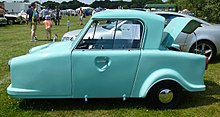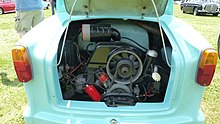Invacar
| Invacar
|
|
|---|---|
| legal form | Limited |
| founding | 1948 |
| resolution | 1977 |
| Reason for dissolution | insolvency |
| Seat | Thundersley ( Essex ), United Kingdom |
| management | Bert Greeves |
| Branch | Automobile manufacturer |
The Invacar Ltd was a British manufacturer of invalids vehicles, in Thundersley at 1948-1977 Southend-on-Sea in Essex was established.
history
In 1948, while mowing the lawn in front of his Worcestershire home , Bert Greeves had the idea of installing the motor of a lawnmower in the wheelchair of his disabled cousin Derry Preston-Cobb . The result was convincing and considering the many disabled British soldiers from World War II , both saw a market for such vehicles. They founded Invarcar Ltd in Thundersley near Southend-on-Sea in Essex in 1948 . Invarcar won a tender from the Ministry of Pensions for a motorized three-wheeled vehicle for the disabled. In addition to Invacar, RA Harding , Dingwall & Son , AC Cars , Barrett , Frankippen & Sons , Thundersley and Coventry Climax were also entrusted by the Ministry with the construction of vehicles for the disabled.
Early designs were of an air-cooled single cylinder - two-stroke engine of Villiers driven cm³ with a displacement of the 147th As the production of this engine beginning of the 1970s has been set, were more powerful four-stroke - boxer engines from Steyr-Puch built cc 500-600 that gave the fellow a top speed of 131 km / h. In the 1960s and 1970s, the Invacar with its modern GRP body and ice-blue paintwork was popularly named “Ministry Blue” (after the Ministry of Health ). Tens of thousands of Invacars were made. Further developments led to a longer wheelbase, a wider track and the use of the Mini's wheels . The last order to build these disabled cars was placed in 1977. There were more than 50 different variants over the entire production period.
As of March 31, 2003, Invacars have been banned from driving on public roads in the UK for safety reasons. The classic car did not meet the modern regulations of the Motorcycle Single Vehicle Approval Scheme , part of the standards prescribed by the EU. At that time, around 200 Invacars were still registered in the UK. Hundreds of Invacars waiting to be used in government warehouses were scrapped along with the spare parts. Some examples have survived in private hands and in museums in the UK and abroad.
All Invacars belonged to the state and were leased to the disabled as part of state welfare. The use of these vehicles has steadily decreased since the introduction of the motability program. This state program enables disabled people and their relatives to purchase a normal car with special modifications.
The Thundersley factory, where Greeves motorcycles were built, closed in 1977 after a fire. Invacar Ltd went bankrupt . Bert Greeves and Derry Preston-Cobb had left the company two years earlier.
literature
- George Nick Georgano (Editor-in-Chief): The Beaulieu Encyclopedia of the Automobile. Volume 2: G – O. Fitzroy Dearborn Publishers, Chicago 2001, ISBN 1-57958-293-1 , p. 759. (English)
Web links
Individual evidence
- ↑ Mirco De Cet, Daniel Quentin (editor): The Complete Encyclopedia of Classic Motorcycles . Rebo International 2005. ISBN 978-90-366-1497-9 .
- ^ Bob Currie: Great British Motorcycles of the Fifties . Hamlyn Publishing Group 1980. ISBN 0-86363-010-3
- ↑ a b c Elvis Payne: Invacar . 3wheelers.com. Retrieved November 24, 2014.
- ^ Tudor van Hampton: Britain's 3-Wheel Solution to Mobility for the Disabled . The New York Times, December 3, 2009. Retrieved November 24, 2014.
- ^ Elvis Payne: The End of the Invacars - Now Banned from British Roads . 3wheelers.com. Retrieved November 24, 2014.
- ↑ a b Gone for a decade - the invalid carriage . BBC News Ouch, June 29, 2013. Retrieved November 24, 2014.
- ↑ Greeves . cybermotorcycle.com . Retrieved November 24, 2014.



